Coffees Brewed from Standard Capsules Help to Compare Different Aroma Fingerprinting Technologies—A Comparison of an Electronic Tongue and Electronic Noses
Abstract
1. Introduction
2. Materials and Methods
2.1. Coffee Samples
2.2. Electronic Tongue Measurements with Astree
2.3. Electronic Nose Measurements with Heracles Neo
2.4. Electronic Nose Measurements with Scout3
2.5. Multivariate Analysis of the E-Tongue and E-Nose Data
3. Results
3.1. Astree E-Tongue Measurements
3.2. Heracles E-Nose Measurements
3.3. Scout3 E-Nose Measurements
4. Discussion
4.1. Discussion of the Results
4.2. Discussion of the Testing Methodology
Supplementary Materials
Author Contributions
Funding
Institutional Review Board Statement
Informed Consent Statement
Data Availability Statement
Acknowledgments
Conflicts of Interest
References
- Nigra, A.D.; Teodoro, A.J.; Gil, G.A. A Decade of Research on Coffee as an Anticarcinogenic Beverage; Hindawi Limited: London, UK, 2021. [Google Scholar] [CrossRef]
- Mahmud, M.M.C.; Shellie, R.A. Unravelling the relationship between aroma compounds and consumer acceptance: Coffee as an example. Compr. Rev. Food Sci. Food Saf. 2020, 19, 2380–2420. [Google Scholar] [CrossRef] [PubMed]
- Safe, S.; Kothari, J.; Hailemariam, A.; Upadhyay, S.; Davidson, L.A.; Chapkin, R.S. Health Benefits of Coffee Consumption for Cancer and Other Diseases and Mechanisms of Action. Int. J. Mol. Sci. 2023, 24, 2706. [Google Scholar] [CrossRef] [PubMed]
- Pabon, C.D.R.; Sánchez-Benitez, J.; Ruiz-Rosero, J.; Ramirez-Gonzalez, G. Coffee Crop Science Metric: A Review; Editora UFLA: Lavras, Brazil, 2020. [Google Scholar] [CrossRef]
- Portela, C.S.; de Almeida, I.F.; Mori, A.L.B.; Yamashita, F.; de T, M. Brewing conditions impact on the composition and characteristics of cold brew Arabica and Robusta coffee beverages. LWT 2021, 143, 111090. [Google Scholar] [CrossRef]
- Assa, A.; Loppies, J.; Amalia, A.; Indriana, D.; Mamang; Utami, R.; Ariyanti, M.; Winaldi, A. Chemical compounds and sensory characteristics of arabica coffee (Coffea arabica) as a novel specialty coffee from Sinjai regency, Indonesia. Food Res. 2021, 5, 107–112. [Google Scholar] [CrossRef] [PubMed]
- Li, J. What Determines Coffee Aroma and Flavor? Berkeley Sci. J. 2022, 26, 59–63. [Google Scholar] [CrossRef]
- Esquivel, P.; Jiménez, V.M. Functional properties of coffee and coffee by-products. Food Res. Int. 2012, 46, 488–495. [Google Scholar] [CrossRef]
- Barbosa, I.P.; de Oliveira, A.C.B.; Rosado, R.D.S.; Sakiyama, N.S.; Cruz, C.D.; Pereira, A.A. Sensory analysis of arabica coffee: Cultivars of rust resistance with potential for the specialty coffee market. Euphytica 2020, 216, 165. [Google Scholar] [CrossRef]
- Nielsen, S.S. Introduction to Food Analysis; Springer: London, UK, 2024; pp. 3–14. [Google Scholar] [CrossRef]
- Marek, G.; Dobrzański, B.; Oniszczuk, T.; Combrzyński, M.; Ćwikła, D.; Rusinek, R. Detection and differentiation of volatile compound profiles in roasted coffee arabica beans from different countries using an electronic nose and GC-MS. Sensors 2020, 20, 2124. [Google Scholar] [CrossRef] [PubMed]
- Viejo, C.G.; Tongson, E.; Fuentes, S. Integrating a low-cost electronic nose and machine learning modelling to assess coffee aroma profile and intensity. Sensors 2021, 21, 2016. [Google Scholar] [CrossRef] [PubMed]
- Michishita, T.; Akiyama, M.; Hirano, Y.; Ikeda, M.; Sagara, Y.; Araki, T. Gas Chromatography/Olfactometry and Electronic Nose Analyses of Retronasal Aroma of Espresso and Correlation with Sensory Evaluation by an Artificial Neural Network. J. Food Sci. 2010, 75, S477–S489. [Google Scholar] [CrossRef] [PubMed]
- Arrieta, A.A.; Núñez, Y.E.; Mendoza, J.M. Mini-electronic tongue used to discriminate between coffee samples of different geographical origin. Int. J. Technol. 2020, 11, 288–298. [Google Scholar] [CrossRef]
- Peryam, D.R.; Girardot, N.F. Advanced taste test method. Food Eng. 1952, 24, 58–61. [Google Scholar]
- Bliss, P.J.; Schulz, T.J.; Senger, T.; Kaye, R.B. Odour measurement—Factors affecting olfactometry panel performance. Water Sci. Technol. 1996, 34, 549–556. [Google Scholar] [CrossRef]
- Sorokowska, A.; Sorokowski, P.; Frackowiak, T. Determinants of human olfactory performance: A cross-cultural study. Sci. Total Environ. 2015, 506–507, 196–200. [Google Scholar] [CrossRef] [PubMed]
- Yakubu, H.G.; Kovacs, Z.; Toth, T.; Bazar, G. Trends in artificial aroma sensing by means of electronic nose technologies to advance dairy production- a review. Crit. Rev. Food Sci. Nutr. 2021, 63, 234–248. [Google Scholar] [CrossRef] [PubMed]
- Tan, J.; Xu, J. Applications of Electronic Nose (e-Nose) and Electronic Tongue (e-Tongue) in Food Quality-Related Properties Determination: A Review; KeAi Communications Co.: Beijing, China, 2020. [Google Scholar] [CrossRef]
- Moshayedi, A.J.; Khan, A.S.; Yang, S.; Geng, K.; Hu, J.; Soleimani, S.; Razi, A. E-Nose design and structures from statistical analysis to application in robotic: A compressive review. EAI Endorsed Trans. AI Robot. 2023, 2, e1. [Google Scholar] [CrossRef]
- Flambeau, K.J.; Lee, W.J.; Yoon, J. Discrimination and geographical origin prediction of washed specialty Bourbon coffee from different coffee growing areas in Rwanda by using electronic nose and electronic tongue. Food Sci. Biotechnol. 2017, 26, 1245–1254. [Google Scholar] [CrossRef] [PubMed]
- Coffee Capsule|Nespresso Hungary. Available online: https://www.nespresso.com/hu/en/order/capsules/original (accessed on 7 July 2025).
- Kovács, Z. Thesis Method to Decrease the Disturbing Effects Occurring by the Electronic Tongue Measurement; Corvinus University of Budapest: Budapest, Hungary, 2012; Available online: https://core.ac.uk/download/pdf/33421263.pdf (accessed on 7 July 2025).
- Kovacs, Z.; Szöllősi, D.; Zaukuu, J.-L.Z.; Bodor, Z.; Vitális, F.; Aouadi, B.; Zsom-Muha, V.; Gillay, Z. Factors Influencing the Long-Term Stability of Electronic Tongue and Application of Improved Drift Correction Methods. Biosensors 2020, 10, 74. [Google Scholar] [CrossRef] [PubMed]
- Næs, T.; Isaksson, T.; Fearn, T.; Davies, T. A User Friendly Guide to Multivariate Calibration and Classification; NIR Publications: Chichester, UK, 2002. [Google Scholar]
- Kovacs, Z.; Pollner, B. Aquaphotomics-Software R-Package Aquap2. In Proceedings of the Understanding Water in Biology 2nd International Symposium, Kobe, Japan, 26–29 November 2016; pp. 26–29. [Google Scholar]
- Costa, A.M.S.; Sobral, M.M.C.; Delgadillo, I.; Rudnitskaya, A. Electronic tongue as a rapid tool for the assessment of coffee flavour and chemical composition. In Proceedings of the IEEE Sensors, Valencia, Spain, 2–5 November 2014; pp. 2126–2129. [Google Scholar] [CrossRef]
- Várvölgyi, E.; Kozits, S.; Soós, J.; Szöllosi, D.; Kovács, Z.; Fekete, A. Application of electronic tongue for distinguishing coffee samples and predicting sensory attributes. Prog. Agric. Eng. Sci. 2012, 8, 49–63. [Google Scholar] [CrossRef]
- Chen, Y.; Gao, B.; Lu, W. Recent Research Advancements of Coffee Quality Detection: Targeted Analyses vs. Nontargeted Fingerprinting and Related Issues. J. Food Qual. 2023, 2023, 6156247. [Google Scholar] [CrossRef]
- Gromski, P.S.; Correa, E.; Vaughan, A.A.; Wedge, D.C.; Turner, M.L.; Goodacre, R. A comparison of different chemometrics approaches for the robust classification of electronic nose data. Anal. Bioanal. Chem. 2014, 406, 7581–7590. [Google Scholar] [CrossRef] [PubMed]
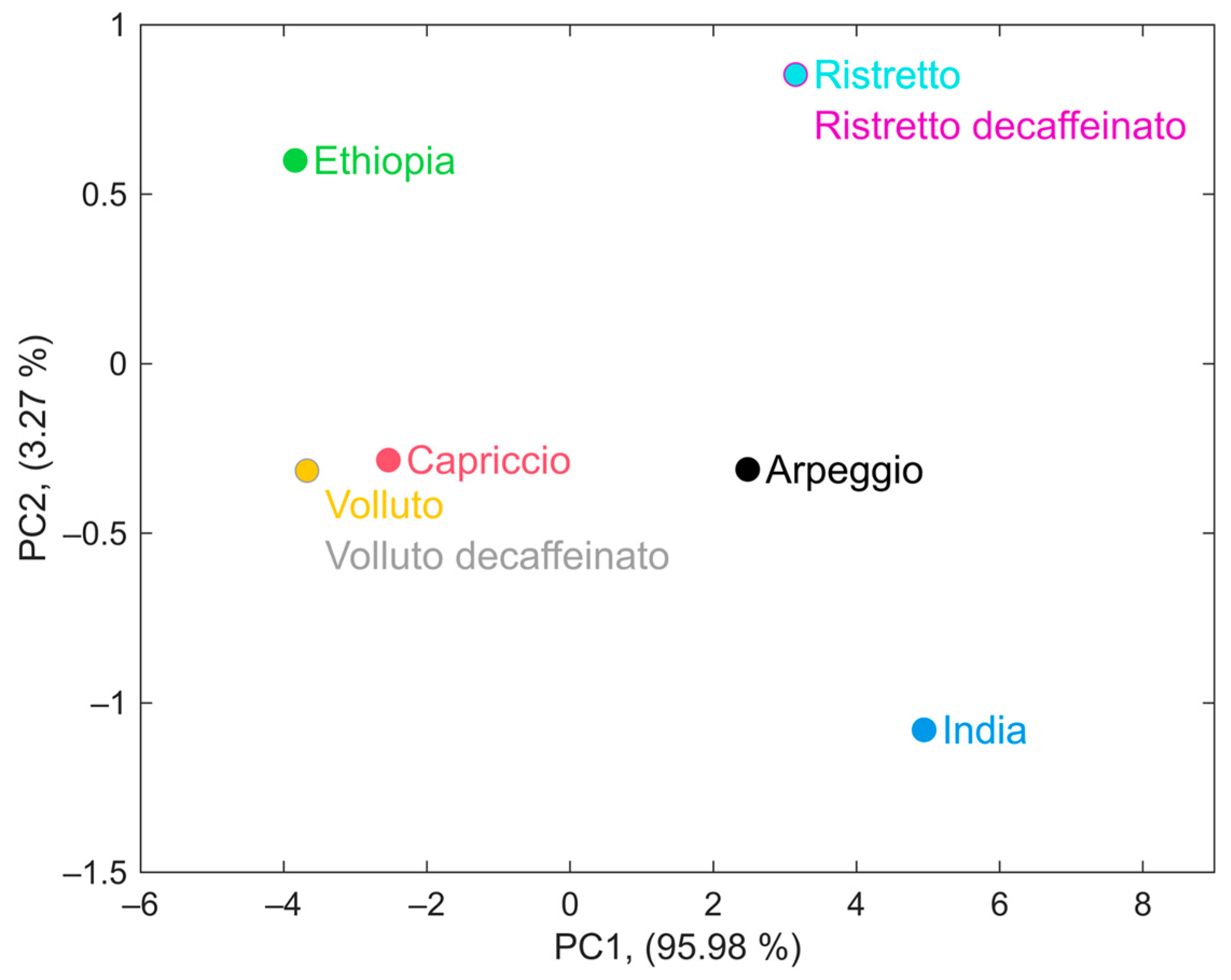
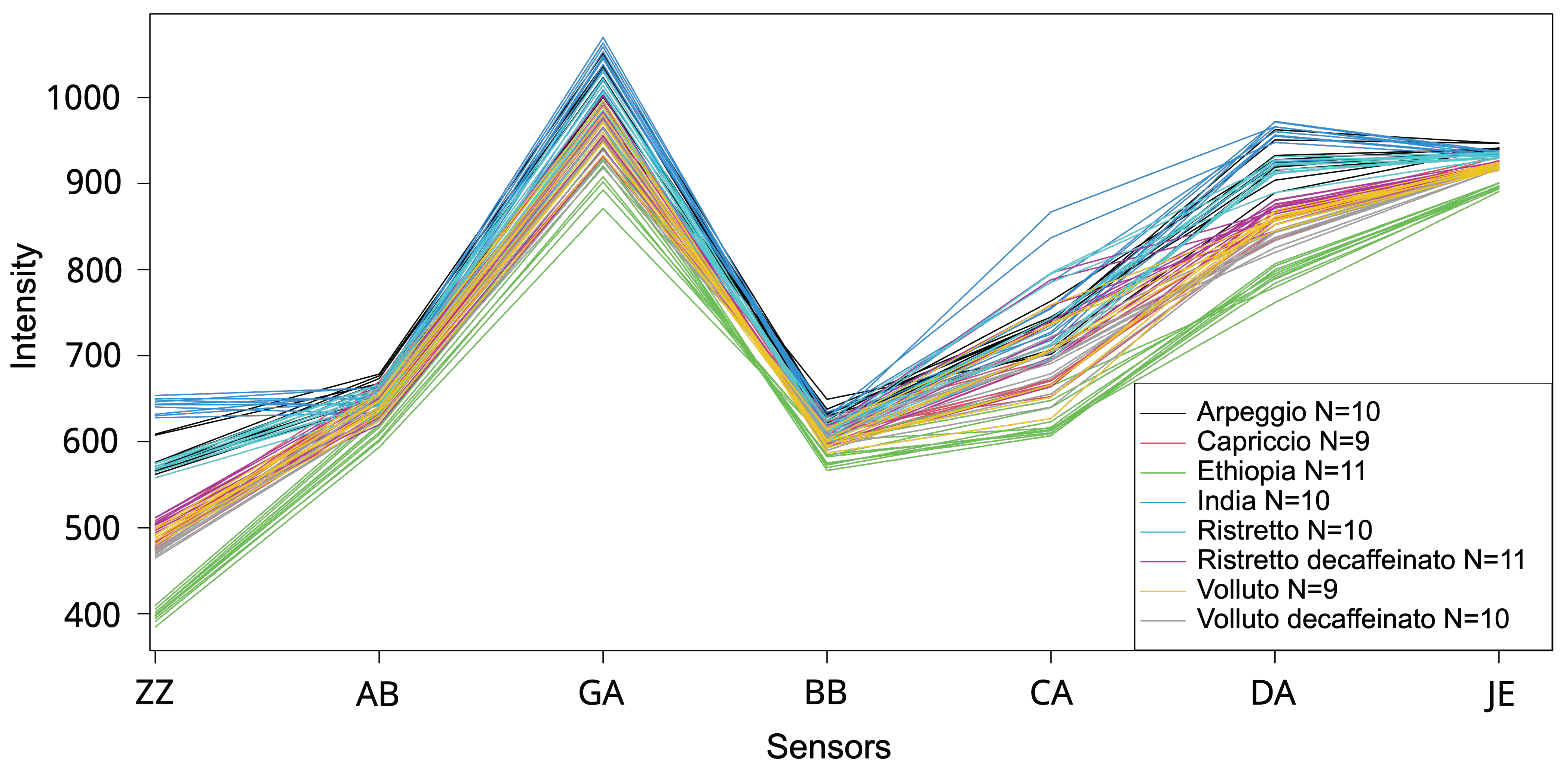
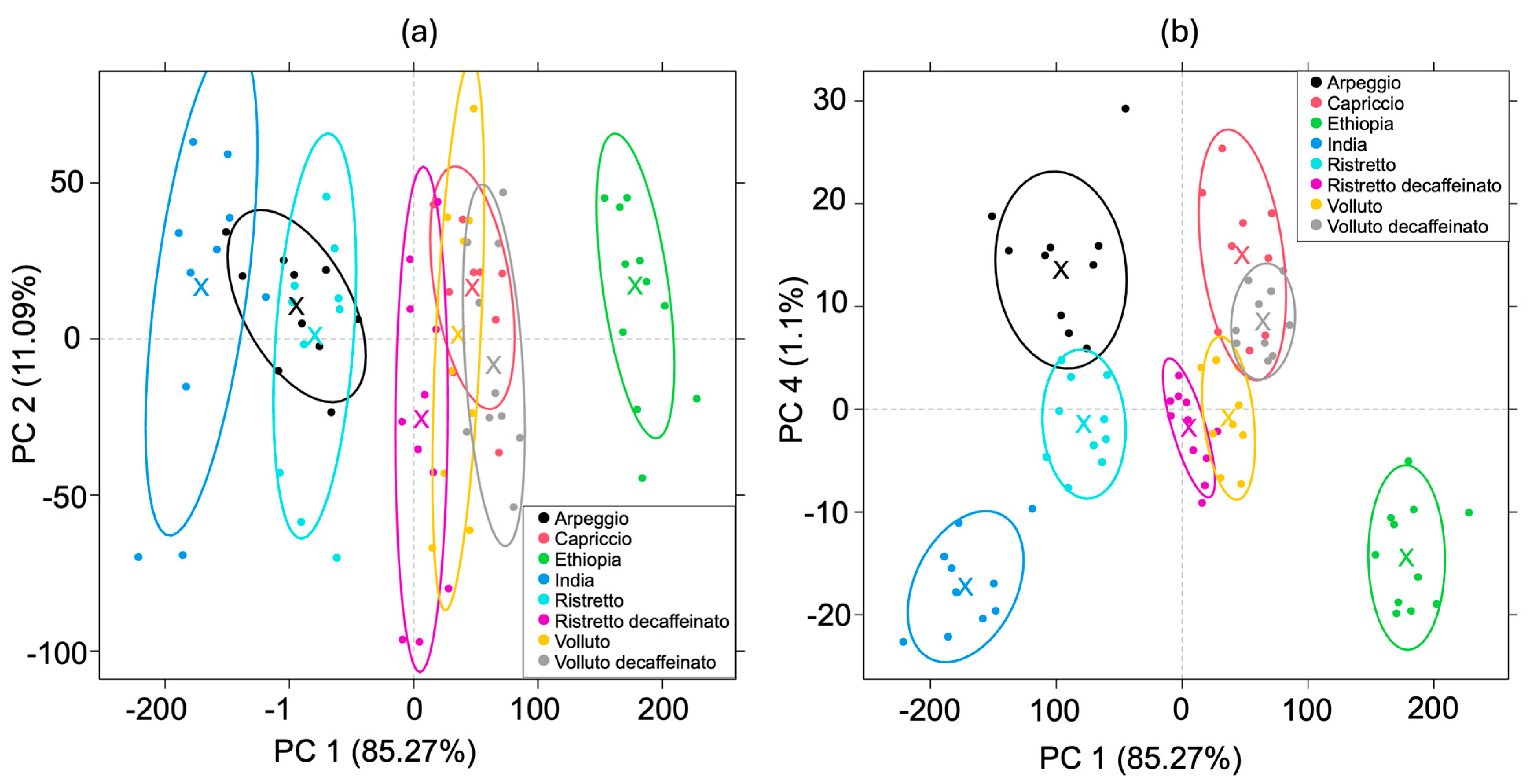
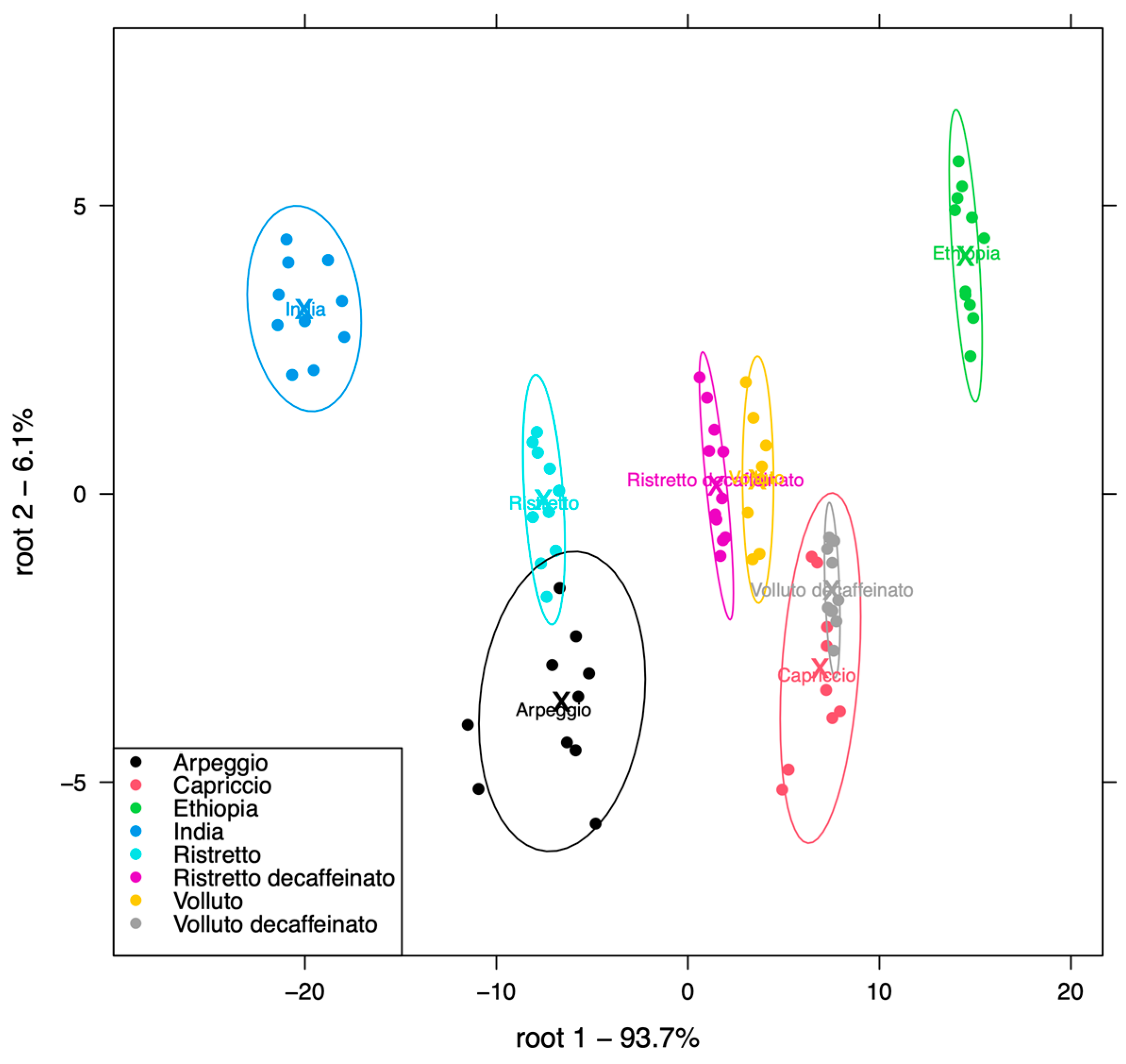
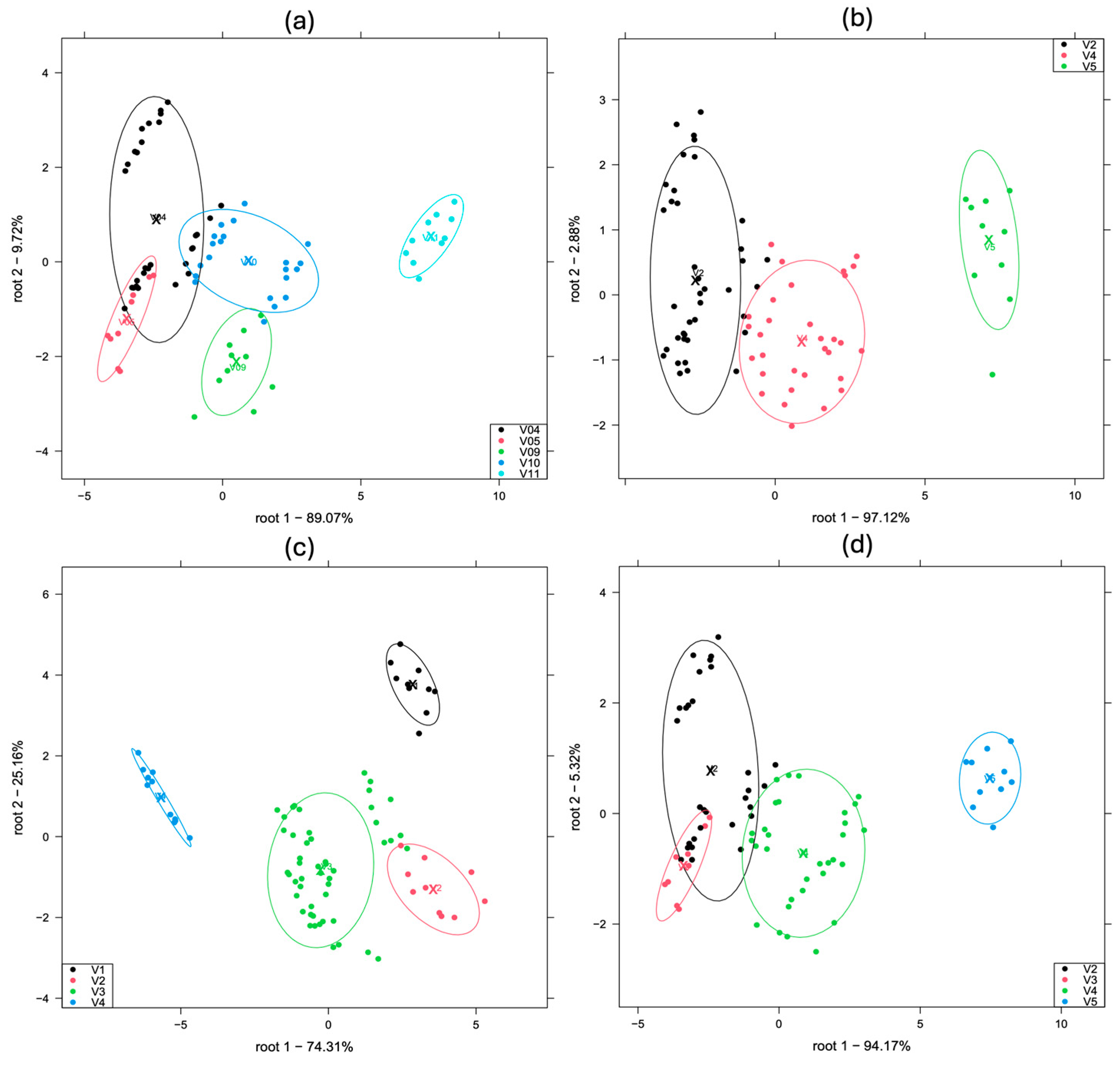
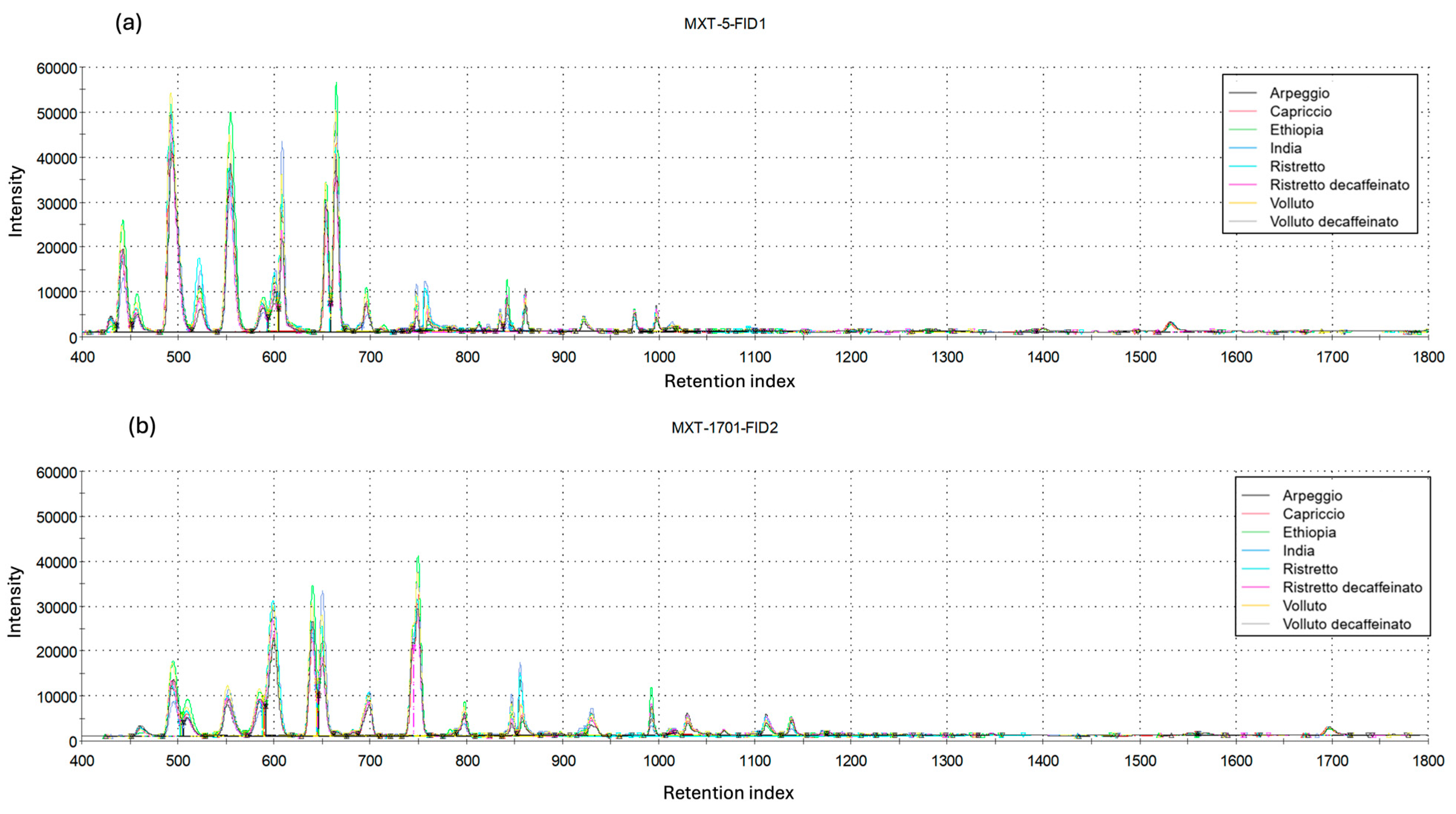

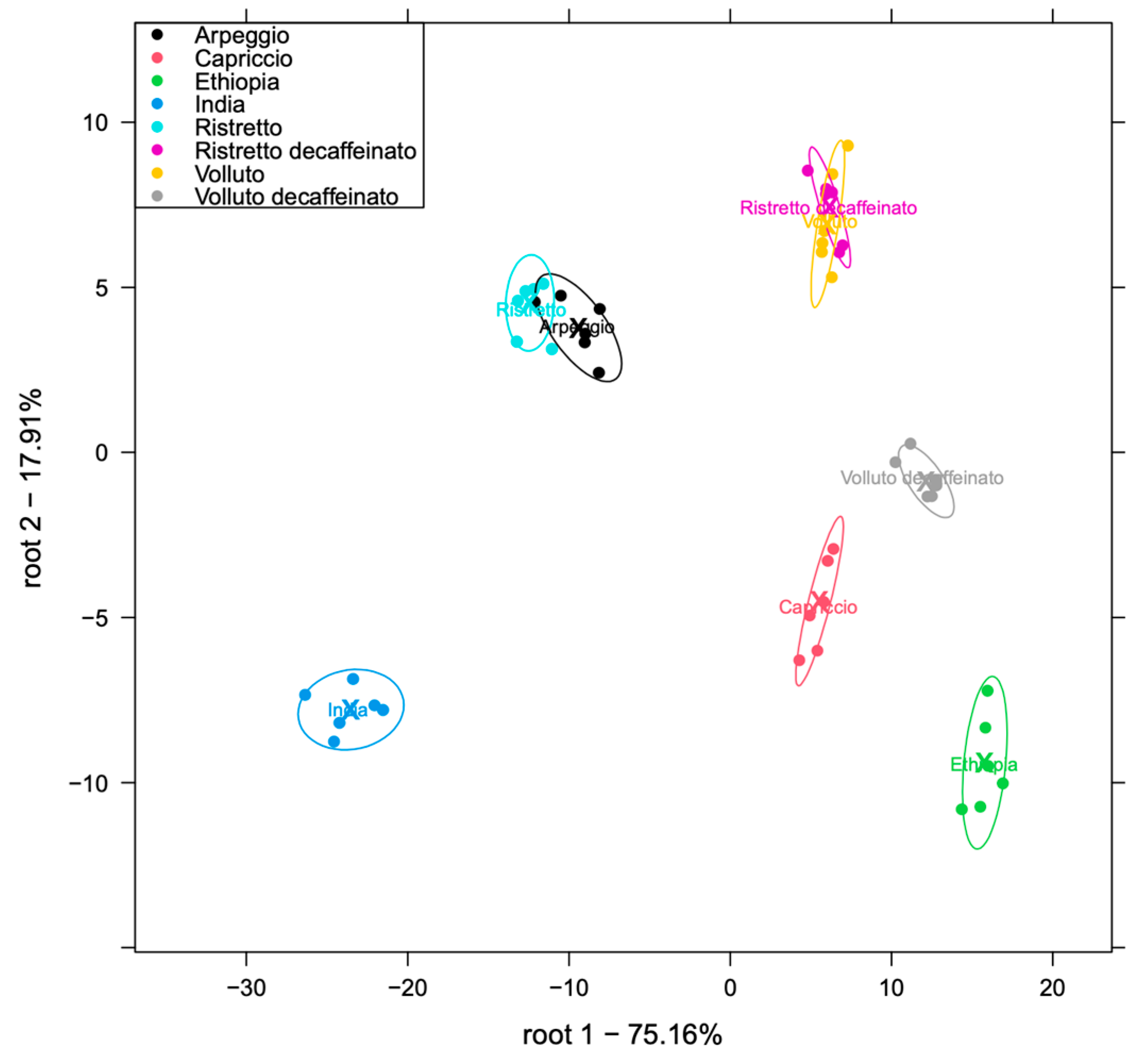




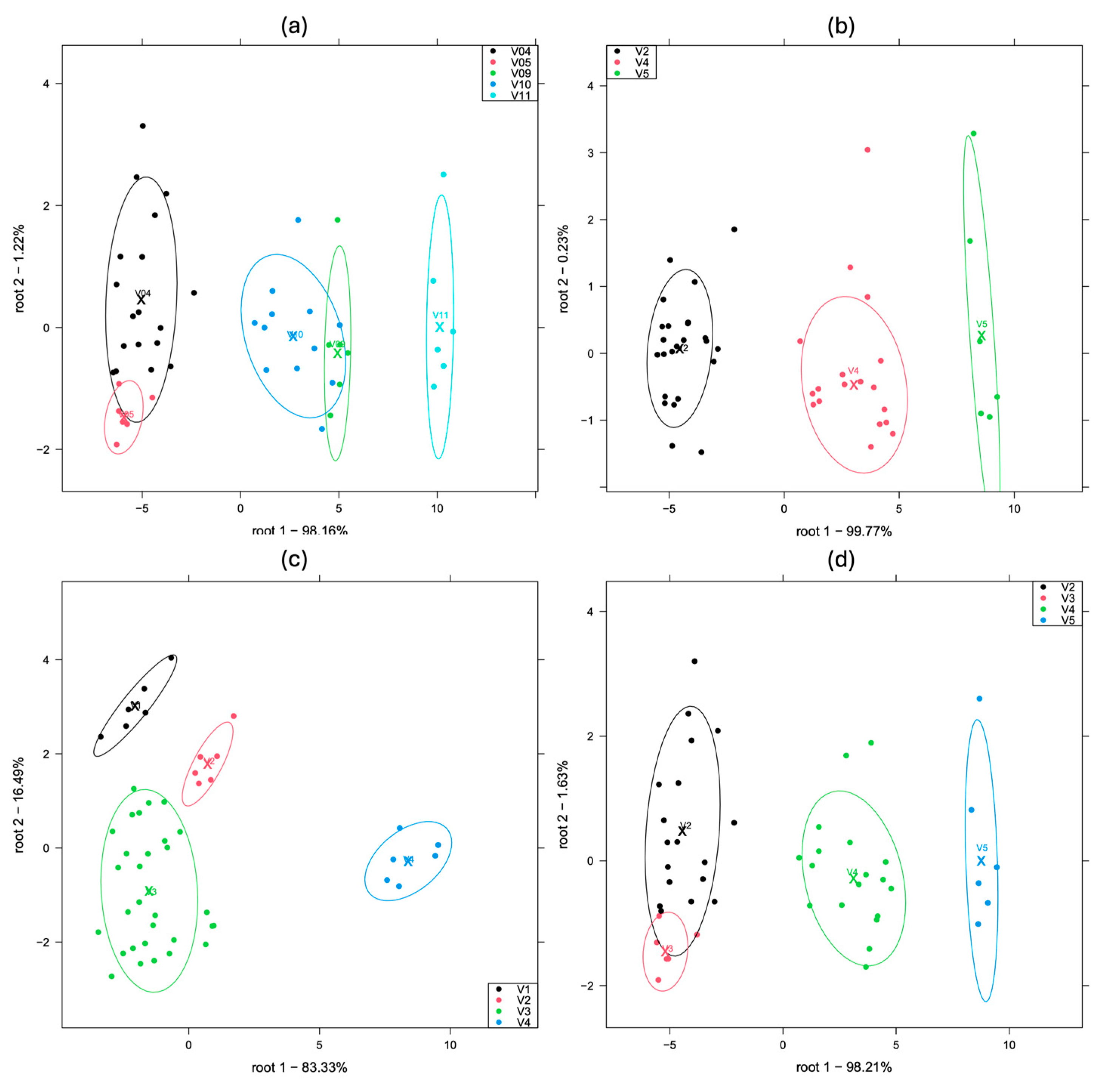
| Coffee Capsule | Ingredients/Origin | Roast Type |
|---|---|---|
| Arpeggio | Pure Arabica from Costa Rica | Deep roasting |
| Capriccio | South American Arabicas (high-altitude), Brazilian Arabica and Robusta | Light roasting |
| Ethiopia | Dry-processed Ethiopian Arabica | Light and short roasting |
| India | Monsooned Indian Robusta and Indian Arabica | Not specified |
| Ristretto | Long-roasted Robusta from South India, quick-roasted Arabicas from Brazil and East Africa | Combination of long and quick roasting |
| Ristretto Decaffeinato | Slow split-roasted Brazilian Arabicas, Robusta from South India, Arabicas from South America and East Africa | Slow split roasting |
| Volluto | Brazilian and Colombian Arabicas | Light roasting |
| Volluto Decaffeinato | Split-roasted Brazilian and Colombian Arabicas | Split roasting |
| Coffee Capsule | Type | Intensity | Roasting | Acidity | Bitterness | Body |
|---|---|---|---|---|---|---|
| Arpeggio | Arabica | 9 | 4 | 2 | 4 | 4 |
| Capriccio | Robusta–Arabica | 5 | 2 | 3 | 3 | 2 |
| Ethiopia | Arabica | 4 | 2 | 4 | 2 | 2 |
| India | Robusta–Arabica | 11 | 5 | 1 | 5 | 4 |
| Ristretto | Robusta–Arabica | 10 | 4 | 3 | 4 | 4 |
| Ristretto decaffeinato | Robusta–Arabica | 10 | 4 | 3 | 4 | 4 |
| Volluto | Arabica | 4 | 2 | 3 | 2 | 2 |
| Volluto decaffeinato | Arabica | 4 | 2 | 3 | 2 | 2 |
| Intensity | Roasting | Acidity | Bitterness | Body | |
|---|---|---|---|---|---|
| Intensity | - | 0.98 | −0.66 | 0.97 | 0.98 |
| Roasting | 0.98 | - | −0.74 | 0.96 | 0.96 |
| Acidity | −0.66 | −0.74 | - | −0.76 | −0.60 |
| Bitterness | 0.97 | 0.96 | −0.76 | - | 0.92 |
| Body | 0.98 | 0.96 | −0.60 | 0.92 | - |
| Groups | Cross-Validation Accuracy of the Astree E-Tongue | Cross-Validation Accuracy of the Heracles E-Nose | Cross-Validation Accuracy of the Scout3 E-Nose |
|---|---|---|---|
| Nespresso® coffee types | 70% | 98% | 92% |
| Intensity | 62% | 85% | 85% |
| Roasting | 81% | 98% | 100% |
| Acidity | 84% | 92% | 96% |
| Bitterness | 74% | 85% | 90% |
| Body | 85% | 100% | 100% |
| Coffee blend | 65% | 75% | 69% |
Disclaimer/Publisher’s Note: The statements, opinions and data contained in all publications are solely those of the individual author(s) and contributor(s) and not of MDPI and/or the editor(s). MDPI and/or the editor(s) disclaim responsibility for any injury to people or property resulting from any ideas, methods, instructions or products referred to in the content. |
© 2025 by the authors. Licensee MDPI, Basel, Switzerland. This article is an open access article distributed under the terms and conditions of the Creative Commons Attribution (CC BY) license (https://creativecommons.org/licenses/by/4.0/).
Share and Cite
Gillay, B.; Gillay, Z.; Kovacs, Z.; Eles, V.; Toth, T.; Yakubu, H.G.; Aldib, I.; Bazar, G. Coffees Brewed from Standard Capsules Help to Compare Different Aroma Fingerprinting Technologies—A Comparison of an Electronic Tongue and Electronic Noses. Chemosensors 2025, 13, 261. https://doi.org/10.3390/chemosensors13070261
Gillay B, Gillay Z, Kovacs Z, Eles V, Toth T, Yakubu HG, Aldib I, Bazar G. Coffees Brewed from Standard Capsules Help to Compare Different Aroma Fingerprinting Technologies—A Comparison of an Electronic Tongue and Electronic Noses. Chemosensors. 2025; 13(7):261. https://doi.org/10.3390/chemosensors13070261
Chicago/Turabian StyleGillay, Biborka, Zoltan Gillay, Zoltan Kovacs, Viktoria Eles, Tamas Toth, Haruna Gado Yakubu, Iyas Aldib, and George Bazar. 2025. "Coffees Brewed from Standard Capsules Help to Compare Different Aroma Fingerprinting Technologies—A Comparison of an Electronic Tongue and Electronic Noses" Chemosensors 13, no. 7: 261. https://doi.org/10.3390/chemosensors13070261
APA StyleGillay, B., Gillay, Z., Kovacs, Z., Eles, V., Toth, T., Yakubu, H. G., Aldib, I., & Bazar, G. (2025). Coffees Brewed from Standard Capsules Help to Compare Different Aroma Fingerprinting Technologies—A Comparison of an Electronic Tongue and Electronic Noses. Chemosensors, 13(7), 261. https://doi.org/10.3390/chemosensors13070261








